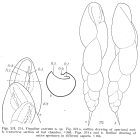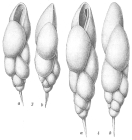RAS taxon details
Stainforthia Hofker, 1956
112117 (urn:lsid:marinespecies.org:taxname:112117)
accepted
Genus
marine, brackish, fresh, terrestrial
recent + fossil
Hofker, J. (1956). Tertiary foraminifera of coastal Ecuador- Part II Additional notes on the Eocene species. <em>Journal of palaeontology.</em> 30: 891-958.
page(s): p. 908 [details] Available for editors
page(s): p. 908 [details] Available for editors
Hayward, B.W.; Le Coze, F.; Vachard, D.; Gross, O. (2025). World Foraminifera Database. Stainforthia Hofker, 1956. Accessed through: RAS (Eds.) (2025) Register of Antarctic Species at: https://ras.biodiversity.aq/aphia.php/www.pfeil-verlag.de/04biol/aphia.php?p=taxdetails&id=112117 on 2025-09-13
RAS (Eds.) (2025). Register of Antarctic Species. Stainforthia Hofker, 1956. Accessed at: https://ras.biodiversity.aq/aphia.php?p=taxdetails&id=112117 on 2025-09-13
Date
action
by
original description
Hofker, J. (1956). Tertiary foraminifera of coastal Ecuador- Part II Additional notes on the Eocene species. <em>Journal of palaeontology.</em> 30: 891-958.
page(s): p. 908 [details] Available for editors
basis of record Gross, O. (2001). Foraminifera, <B><I>in</I></B>: Costello, M.J. <i>et al.</i> (Ed.) (2001). <i>European register of marine species: a check-list of the marine species in Europe and a bibliography of guides to their identification. Collection Patrimoines Naturels,</i> 50: pp. 60-75 (look up in IMIS) [details]
additional source Loeblich, A. R.; Tappan, H. (1987). Foraminiferal Genera and their Classification. Van Nostrand Reinhold Company, New York. 970pp., available online at https://books.google.pt/books?id=n_BqCQAAQBAJ [details] Available for editors
additional source Revets, S. A. (1996). The generic revision of five families of Rotaliine Foraminifera - Part 1. The Bolivinitidae Cushman, 1927. <em>Cushman Foundation for Foraminiferal Research, Special Publication.</em> 1-55., available online at https://cushmanfoundation.allenpress.com/Portals/_default/SpecialPublications/sp34.pdf [details] Available for editors
page(s): p. 908 [details] Available for editors
basis of record Gross, O. (2001). Foraminifera, <B><I>in</I></B>: Costello, M.J. <i>et al.</i> (Ed.) (2001). <i>European register of marine species: a check-list of the marine species in Europe and a bibliography of guides to their identification. Collection Patrimoines Naturels,</i> 50: pp. 60-75 (look up in IMIS) [details]
additional source Loeblich, A. R.; Tappan, H. (1987). Foraminiferal Genera and their Classification. Van Nostrand Reinhold Company, New York. 970pp., available online at https://books.google.pt/books?id=n_BqCQAAQBAJ [details] Available for editors
additional source Revets, S. A. (1996). The generic revision of five families of Rotaliine Foraminifera - Part 1. The Bolivinitidae Cushman, 1927. <em>Cushman Foundation for Foraminiferal Research, Special Publication.</em> 1-55., available online at https://cushmanfoundation.allenpress.com/Portals/_default/SpecialPublications/sp34.pdf [details] Available for editors
 Present
Present  Inaccurate
Inaccurate  Introduced: alien
Introduced: alien  Containing type locality
Containing type locality


